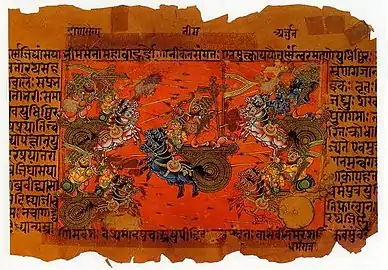Parikshit
Parikshit (Sanskrit: परीक्षित्, IAST: Parīkṣit[note 1]) was a Kuru king who reigned during the Middle Vedic period (12th-9th centuries BCE).[1] Along with his son and successor Janamejaya, he played a decisive role in the consolidation of the Kuru state, the arrangement of Vedic hymns into collections, and the development of the orthodox srauta ritual, transforming the Kuru realm into the dominant political and cultural center of northern Iron Age India.[2]
| Parikshit | |
|---|---|
| King of Kuru Kingdom | |
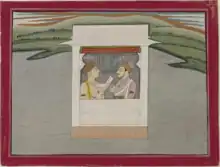 Sage Shuka and King Parikshit | |
| Predecessor | Arjuna (Grandfather), Yudhishthira (Grand uncle) |
| Successor | Janamejaya (son) |
| Spouse | Madravti |
| Issue | Janamejaya Bhimasena Srutasena Ugrasena |
| Father | Abhimanyu |
| Mother | Uttarā |
He also appears as a figure in later legends and traditions. According to the Mahabharata and the Puranas, he succeeded his grand uncle Yudhishthira to the throne of Hastinapur.[note 2]
Mentions
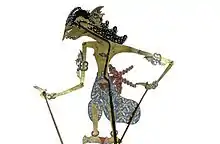
"Listen to the good praise of the King belonging to all people, who, (like) a god, is above men, (listen to the praise) of Parikṣit! - ‘Parikṣit has just now made us peaceful dwelling; darkness has just now run to its dwelling.’ The Kuru householder, preparing (grains) for milling, speaks (thus) with his wife. — ‘What shall I bring you, sour milk, the mantha [a barley/milk drink?' the wife keeps asking in the Realm of King Pariksit. — By itself, the ripe barley bends heavily (iva) over the deep track of the path. The dynasty thrives auspiciously in the Realm of King Parikṣit.”[7][8]
Parikshit is eulogised in a hymn of the Atharvaveda (XX.127.7-10) as a great Kuru king (Kauravya), whose realm flowed with milk and honey and people lived happily in his kingdom. He is mentioned as the raja vishvajanina (universal king).[9]
Few other details about his reign are recorded in Vedic literature. According to the Mahabharata, Parikshit married princess Madravati of the Madra Kingdom, reigned for 24 years, and died at the age of 60, but this is a much later text and cannot be confirmed as historical fact.[10]
Historicity
.png.webp)
Michael Witzel dates the Pārikṣita Dynasty of the Kuru Kingdom to the 12th-11th centuries BC.[11] H.C. Raychaudhuri dates Parikshit in ninth century BC.[12] He was succeeded by his son Janamejaya.[13]
Only one Parikshit is mentioned in Vedic literature; however, post-Vedic literature (Mahabharata and Puranas) seems to indicate the existence of two kings by this name, one who lived before the Kurukshetra War was an ancestor to the Pandavas, and one who lived later and was a descendant. Historian H. C. Raychaudhuri believes that the second Parikshit's description better corresponds to the Vedic king, whereas the information available about the first is scanty and inconsistent, but Raychaudhuri questions whether there were actually two distinct kings. He suggests that the doubling was eventually "invented by genealogists to account for anachronisms" in the later parts of the Mahabharata, as "a bardic duplication of the same original individual regarding whose exact place in the Kuru genealogy no unanimous tradition had survived," and therefore there "is an intrusion into the genealogical texts" of the late, post-Vedic tradition, which also has two of Parikshit's son Janamejaya.[14][note 3]
Family
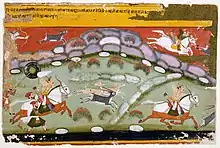

There is no unanimity regarding the father of Parikshit among epics and Puranas. He is depicted as the son of Abhimanyu, but is more popular as Abhimanyu's posthumous son.[15][16]
According to the Shatapatha Brahmana (XIII.5.4), Parikshita had four sons, Janamejaya, Bhimasena, Ugrasena and Śrutasena. All of them performed the Asvamedha Yajna .[17]
His bodily existence ended due to the curse of a Brahmana, who used the Nāga king, Takshaka, the ruler of Taxila as the instrument of death.[18] Parikshit was the husband of Queen Madravati and was succeeded by his son Janamejaya.[19] According to the Mahabharata, he ruled for 24 years and died at the age of sixty.[20]
A thesis based upon Ugrasravas’ narration suggests an alternative interpretation regarding Parikshit’s lineage. In this interpretation, Parikshit fathered a firstborn son with an unnamed putrika wife. Albeit the child was Parikshit’s firstborn, he was the son of a putrika and therefore could not succeed his father on the throne as he was to be the heir of his maternal grandfather. This son’s name was Sringin; his maternal grandfather was Samika. As this would leave Parikshit without an heir, he had another son, Janamejaya, with a second wife, Madravati. Sringin and Samika are seen again in the hunting story that results in Parikshit’s demise.
Prophecy of Life

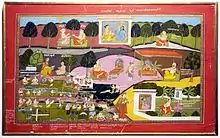
The Bhagavata Purana (1.8.9) states that the son of Drona, Ashwatthama had prepared a Brahmastra (a powerful weapon summoned to Brahma) to kill the Pandavas heir(King Parikshit), while he was in his mother's (Uttarā) womb, as a revenge against the Pandavas for killing his relatives (especially his father and best friend Duryodhan) in the Kurukshetra war. Uttarā was terrified by the powerful rays of the weapon and worried about her child, then her mothers-in-law Draupadi and Subhadra prayed to Krishna for help to save their heir. Krishna pacified her and protected the child in the womb from the deadly weapon and thus saved his life. Parikshit was thus born to Uttara and later was throned as the heir to the Pandavas at Hastinapura.[21]
Death
_and_parikshit_bitten_by_Takshak.jpg.webp)
Parikshit was cursed by Rishi Shamika's son Sringin, to die of Snakebite in seven days, for disrespecting Rishi Shamika.[22] Parikshit, died after Takshaka king of snakes bit him.[23]
Death of Parikshit is also governed by another flashback when the Pandavas conquered Khandavprastha (now known as Indraprastha). Takshaka is the head of snakes, who was residing in Nagaloka without any human disturbance. When Pandavas arrived, Takshaka felt his freedom is seized, with pure anger, he ordered his troops to attack the Pandavas and their subjects. The widespread attack resulted in the death of many people, or everyone except the Pandavas and their wife Draupadi. After this incident, Arjuna, the third Pandava, lifted his bow and set fire to the Nagaloka. Takshaka grew even more furious and vowed to kill one of the lineages of the Pandavas. The vow of Takshaka and the curse of Rishi Shamika's son Sringin gave the ultimate destiny of Parikshit that he will be killed by a snakebite.
Now, on hearing his father's death by Takshaka, Parikshit's son Janamejaya II vowed to kill Takshaka within a week. He starts the Sarpamedha yagna, which forced each and every snake of the entire universe to fall in the havan kund. However one snake got stuck around Surya's chariot and because of the force of yagna the chariot was also getting pulled inside the hawankund. This could have ended up taking the Surya's chariot in the sacrificial altar and ending the regime of Sun from the universe. This resulted in plea from all the gods to stop the sacrifice. When Takshaka arrived then this yagna was stopped from doing so by Astika Muni, as a result of which Takshaka lived. That day was Shukla Paksha Panchami in the month of Shravan and is since celebrated as the festival of Naga Panchami.[24]
See also
| Wikimedia Commons has media related to Parikshit. |
Notes
- "Parīkṣit" is the correct Sanskrit form of the name. "Pārikṣita" refers to a son/descendant of Parikṣit, e.g. Janamejaya (Witzel 1997). Parīkṣita is a past participle meaning "examined", not a name.
- According to the Mahabharata his capital was at Hastinapura. But the Vedic literature indicates that the early Kurus had their capital at Āsandīvat,[3] identified with modern Assandh in Haryana.[4][5][6]
- Also, Witzel (1995) only refers to one Parikshit and one Janamejaya.
References
Citations
- Michael Witzel (1989), Tracing the Vedic dialects in Dialectes dans les litteratures Indo-Aryennes ed. Caillat, Paris, 97–265.
- Michael Witzel, "Early Sanskritization. Origins and development of the Kuru State". B. Kölver (ed.), Recht, Staat und Verwaltung im klassischen Indien. The state, the Law, and Administration in Classical India. München : R. Oldenbourg 1997, 27-52 "Archived copy". Archived from the original on 15 August 2006. Retrieved 5 July 2010.CS1 maint: archived copy as title (link)
- Michael Witzel, "Early Sanskritization. Origins and development of the Kuru State". B. Kölver (ed.), Recht, Staat und Verwaltung im klassischen Indien. The state, the Law, and Administration in Classical India. München : R. Oldenbourg 1997, 27-52 "Archived copy". Archived from the original on 15 August 2006. Retrieved 5 July 2010.CS1 maint: archived copy as title (link)
- "Prāci-jyotī: Digest of Indological Studies". 1967.
- Dalal, Roshen (2010). Hinduism: An Alphabetical Guide. ISBN 9780143414216.
- Raychaudhuri 2006, p. 18.
- Witzel 1997
- Bloomfield, Hymns of the Atharva-Veda. (Sacred Books of the East 42.) Oxford 1897, repr. Delhi 1964
- Raychaudhuri 2006, pp. 10-13.
- Raychaudhuri (1996), p.19
- Michael Witzel (1989), Tracing the Vedic dialects, p.141
- Raychaudhuri 2006, p. 29.
- Raychaudhuri 2006, p. 30.
- Raychaudhuri (1996), pp.13-19
- Raychaudhuri 2006, pp. 11-16.
- Dowson, John (1888). A Classical Dictionary of Hindu Mythology and Religion, Geography, History, and Literature. Trubner & Co., London. p. 1.
- Raychaudhuri 2006, pp. 14,39.
- "Maharaja Parikshit". Archived from the original on 14 July 2006.
- Misra, V.S. (2007). Ancient Indian Dynasties, Mumbai: Bharatiya Vidya Bhavan, ISBN 81-7276-413-8, p.278
- Raychaudhuri 2006, pp. 19.
- "Who was Raja Parikshit in Mahabharat and why the story of his death is philosophical". www.timesnownews.com. Retrieved 29 August 2020.
- http://ritsin.com/story-raja-parikshit-snake-sacrifice-janmejaya.html/
- http://ritsin.com/story-raja-parikshit-snake-sacrifice-janmejaya.html/
- Garg 1992, p. 743.
Sources
- Garg, Gaṅgā Rām (1992), Encyclopaedia of the Hindu World, Concept Publishing Company, ISBN 978-81-7022-376-4, retrieved 2 August 2013
- Raychaudhuri, Hemchandra (2006), Political History of Ancient India, Cosmo Publications, ISBN 81-307-0291-6
